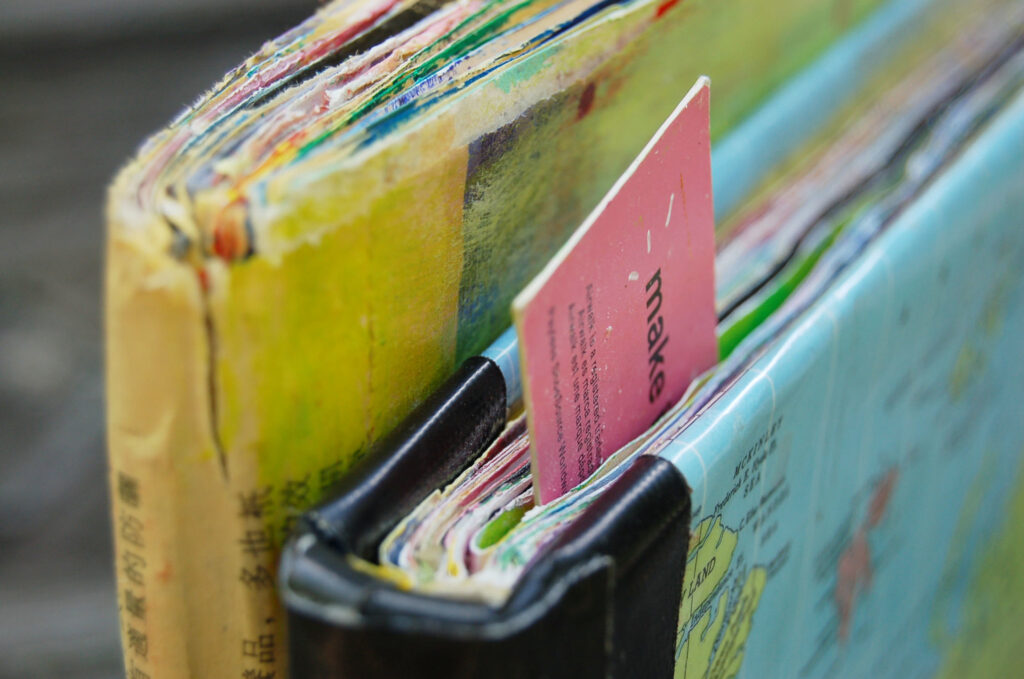This post was originally published on the My Peacetree blog. Read more about these archives.

One of the most wonderful things about art journaling – and one of the hardest to become comfortable with – is that there is no wrong way to do it. You can’t screw up. Which means, too, that there are no guidelines for what is “right” or “good”, and it can be difficult to find your way without any boundaries at all.
Additionally, especially while embarking into newness, we set expectations based on the results of individuals who have spent years honing their style and technique. I thought I’d address some of the myths that I have struggled with while on my own art journaling journey, in hopes of helping you to be gentle with yourself while you begin or continue with your artistic journey.
Myth #1: You need a main focus/image.
Sometimes my pages are dominated by a central image, but usually they are not. Often, a color scheme is all I use to tie a spread together. Try creating a page that feels loose and spontaneous and purposefully vast, try creating a page with a main focus, and try creating one that has a balance – and decide for yourself what feels best for you.
Myth #2: You next text — text that is beautiful and wise and poignantly written about growth or struggle.
This is one that I struggled with for a long time. I felt like I was missing some important element of the process of art journaling by not being struck by some magnificent revelation while painting. But I have found that, for me, it is the process that is most important, and I don’t have use a quote to prove (to myself or to others) how art journaling benefits me.
Alternately, if you are looking to use text in your art but don’t know what to write, try a stream-of-consciousness approach: write for a set amount of time without stopping and without thinking too hard about what comes next. (For example: “Now I’m doing stream-of-consciousness but I don’t really know what I’m writing and it’s weird but oh well I’m trying to fill up text and here’s the end of the sentence.”) Most of the text in my art journal is this kind of writing!
Myth #3: You need to paint.
Scared of paint? No worries. Start with what you feel comfortable with, whether it be collage, ballpoint pen, crayon, sharpie, pencil, marker, charcoal, or something else entirely.
Myth #4: You need to draw/paint/sketch figures.
Nope. Creating realistic images takes time, patience, and passion. If you are interested in getting better, go for it! Otherwise, skip what you’re not interested in (or yet not ready to attempt) and experiment with color, texture, and other abstract concepts, or use magazine or catalogue images for figures you want to include.
Myth #5: You need expensive materials.
In art journaling, cheap is possible without sacrificing beauty. Try using items you probably already have at home or can snap up for just a few dollars: a thrifted book, watercolors and brushes from the dollar store, newspaper, crayons, magazines, tissue paper, scrap paper, glue stick, staples, masking tape, ink-jet printed text and images. And, if you want to spring for it, an acrylic paint set under $10. Crayola has some fantastic materials, too, many for under $5.
Using cheaper materials, incidentally, lessens the fear of wasting product and makes it easier to experiment!
Myth #6: Every page has to be “finished” before you start the next one.
One of my greatest inspirations once posted something that forever changed how I approached my art journal. I paraphrase: “If you don’t like what you’ve created, turn the page and start again.” It takes courage to stop, turn to a new page, release whatever frustration you may be feeling, and try something new. But my goodness, loves, is it so exhilarating to give yourself permission to screw up and move on!
Don’t spend all your time and energy wrestling with something that isn’t turning out the way you’ve envisioned. Put it behind you, turn the page, and start again.
Myth #7: The pages have to be done in order.
I skip around in my art journal all the time, inspired by the images that are on the pages of my thrifted books and my whimsy. Follow your instinct! Incidentally, if you are using an altered book, switching between working in the first half and the last half of the book actually helps to keep the spine more even.
Myth #8: You are a serious art journaler only if you do it every day.
This is something I still struggle with: admitting that months sometimes go by between when I pick up my brush. But you know what? Fact is, I paint when the inspiration strikes, and that means that I do not paint regularly. While I know that I love art journaling, and often I fall into a creative streak when I force myself to put color on the pages, it is important for us to be gentle with ourselves, especially when it comes to our passions.
Is there anything that you have struggled with while art journaling? What is holding you back?

